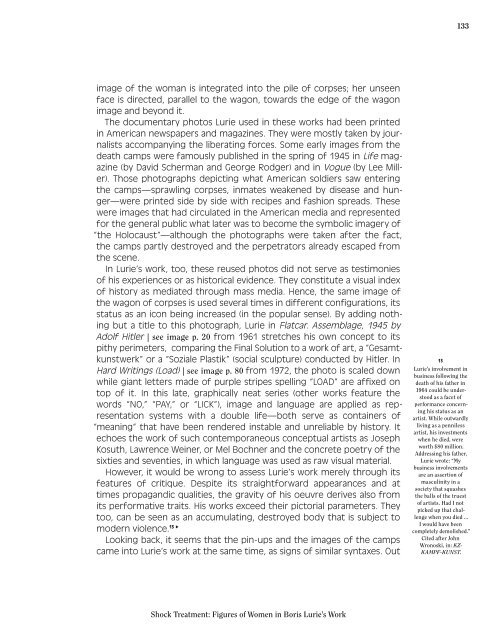The Art of
Katalog_Boris-Lurie_English
Katalog_Boris-Lurie_English
You also want an ePaper? Increase the reach of your titles
YUMPU automatically turns print PDFs into web optimized ePapers that Google loves.
133<br />
image <strong>of</strong> the woman is integrated into the pile <strong>of</strong> corpses; her unseen<br />
face is directed, parallel to the wagon, towards the edge <strong>of</strong> the wagon<br />
image and beyond it.<br />
<strong>The</strong> documentary photos Lurie used in these works had been printed<br />
in American newspapers and magazines. <strong>The</strong>y were mostly taken by journalists<br />
accompanying the liberating forces. Some early images from the<br />
death camps were famously published in the spring <strong>of</strong> 1945 in Life magazine<br />
(by David Scherman and George Rodger) and in Vogue (by Lee Miller).<br />
Those photographs depicting what American soldiers saw entering<br />
the camps—sprawling corpses, inmates weakened by disease and hunger—were<br />
printed side by side with recipes and fashion spreads. <strong>The</strong>se<br />
were images that had circulated in the American media and represented<br />
for the general public what later was to become the symbolic imagery <strong>of</strong><br />
“the Holocaust”—although the photographs were taken after the fact,<br />
the camps partly destroyed and the perpetrators already escaped from<br />
the scene.<br />
In Lurie’s work, too, these reused photos did not serve as testimonies<br />
<strong>of</strong> his experiences or as historical evidence. <strong>The</strong>y constitute a visual index<br />
<strong>of</strong> history as mediated through mass media. Hence, the same image <strong>of</strong><br />
the wagon <strong>of</strong> corpses is used several times in different configurations, its<br />
status as an icon being increased (in the popular sense). By adding nothing<br />
but a title to this photograph, Lurie in Flatcar. Assemblage, 1945 by<br />
Adolf Hitler | see image p. 20 from 1961 stretches his own concept to its<br />
pithy perimeters, comparing the Final Solution to a work <strong>of</strong> art, a “Gesamtkunstwerk”<br />
or a “Soziale Plastik” (social sculpture) conducted by Hitler. In<br />
Hard Writings (Load) | see image p. 80 from 1972, the photo is scaled down<br />
while giant letters made <strong>of</strong> purple stripes spelling “LOAD” are affixed on<br />
top <strong>of</strong> it. In this late, graphically neat series (other works feature the<br />
words “NO,” “PAY,” or “LICK”), image and language are applied as representation<br />
systems with a double life—both serve as containers <strong>of</strong><br />
“meaning” that have been rendered instable and unreliable by history. It<br />
echoes the work <strong>of</strong> such contemporaneous conceptual artists as Joseph<br />
Kosuth, Lawrence Weiner, or Mel Bochner and the concrete poetry <strong>of</strong> the<br />
sixties and seventies, in which language was used as raw visual material.<br />
However, it would be wrong to assess Lurie’s work merely through its<br />
features <strong>of</strong> critique. Despite its straightforward appearances and at<br />
times propagandic qualities, the gravity <strong>of</strong> his oeuvre derives also from<br />
its performative traits. His works exceed their pictorial parameters. <strong>The</strong>y<br />
too, can be seen as an accumulating, destroyed body that is subject to<br />
modern violence. 13<br />
Looking back, it seems that the pin-ups and the images <strong>of</strong> the camps<br />
came into Lurie’s work at the same time, as signs <strong>of</strong> similar syntaxes. Out<br />
13<br />
Lurie’s involvement in<br />
business following the<br />
death <strong>of</strong> his father in<br />
1964 could be understood<br />
as a facet <strong>of</strong><br />
performance concerning<br />
his status as an<br />
artist. While outwardly<br />
living as a penniless<br />
artist, his investments<br />
when he died, were<br />
worth $80 million.<br />
Addressing his father,<br />
Lurie wrote: “My<br />
business involvements<br />
are an assertion <strong>of</strong><br />
masculinity in a<br />
society that squashes<br />
the balls <strong>of</strong> the truest<br />
<strong>of</strong> artists. Had I not<br />
picked up that challenge<br />
when you died ...<br />
I would have been<br />
completely demolished.”<br />
Cited after John<br />
Wronoski, in: KZ-<br />
KAMPF-KUNST.<br />
Shock Treatment: Figures <strong>of</strong> Women in Boris Lurie’s Work



